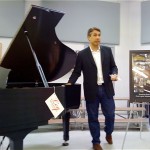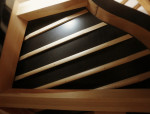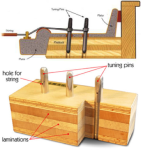Introducing Piano Maker’s Corner!
 Ta da! Today we kick off a New PA column, Piano Maker’s Corner!
Ta da! Today we kick off a New PA column, Piano Maker’s Corner!
Each month, right here on Piano Addict, piano craftsman, technician (and, of course, addict) Daniel Ley, will be posting about general piano care and his journey as designer and maker of The Monserrat Grand Piano.
You will get pointers on piano care, history, and maintenance, plus the inside scoop on the life of a 21st Century grassroots, handcrafted piano maker. There are only a few handcrafted piano companies currently operating in the United States and Daniel’s new, Arizona built, grand piano is truly making history.
Here’s a recent video interview by blogger, Zac Baker.
I featured Daniel and his new “made in America” piano in a post after the premier of his first piano in October of 2010. I’m excited to hear what has happened in the last 4 years—from the surprises, to the successes and failures, to the humorous. It will be wonderful to share this journey with him, his craftsmen, and apprentices.
Now, 4 years after the premier of the Monserrat, here’s some of what Daniel has to say about himself, his piano, and Piano Maker’s Corner:
At Ley Piano Company passion for piano craftsmanship is alive and well. I founded the company specializing in traditional piano care and service. I hired passionate, skilled craftsmen with a desire to continue the tradition of quality piano care into the modern day.
20 years later we continue to carry on that tradition. In addition to full service piano care, we enthusiastically have designed and built a grand piano… the Monserrat. The goal was to design thinking of what its like as a technician, to purchase high quality parts from businesses with longevity, and to make an instrument that was reasonably priced for all piano lovers. The Monserrat is a labor of love built with the customer in mind.
Learning the realities of manufacturing a piano was not as simple as I thought it would be. One big obstacle was learning who was actually making the parts we needed. One example was when we went to purchase screws from a company in Chicago. After during a lot of research we learned that the screws were actually made in Indonesia and just stored and shipped from Chicago. We then had to find another supplier that manufactured here in the United States. Over the last 5 years we have found out the actual origins of many other piano makers parts and now take a lot of time to research the companies we work with so we can be sure we are using the highest quality and know the product history.
I’m excited to help answer any questions you all may have about piano care, services, and history from the unique perspective of a technician and small manufacturer.
July Piano Maker’s Q&A: Humidity & Sticky Keys
Q: What do I do when my keys become sticky in humid months? Sometimes it is hard to play at all because I have to unstick keys after every time I press them.
A: One of the most common things we get calls and questions about is why our pianos get “sticky keys.” As Arizonans, we spend all year waiting for the monsoons. In the excitement it is easy to forget how much the humidity increases during this time. Humidity leads to swelling wood, which leads to sticking keys. A technician could come out and work with the action but then when the humidity drops again the problem will probably be solved on it’s own.It is best to just play the keys as often as possible and be patient. If that doesn’t solve the issue, then you should call your technician.As regards humidifying or dehumidifying, the goal is to keep it consistent. So if your climate varies greatly be sure you are keeping the humidity levels as stable as possible.
So, bring on the questions fellow addicts!!!
Have questions for Daniel? You can submit questions for future Piano Maker’s Corner posts by commenting below or using the gray contact tab at the top of this page.
You can learn more about Ley Piano Company and the Monserrat here. You can read about piano care here. Like Ley Piano Company on Facebook for photos of current projects and piano news.


I appreciate your work. You pay attention to important aspects of the use of the piano in your region. Also the production of pianos is not the most popular topic on the internet, so it’s fantastic that there are sites like this one!
Very interesting, I’ve been always interested about how they make new pianos. I believe techniques of manufacturing haven’t changed much through the centuries and they still rely on hand craftsmanship. I’m sure I’ll be following piano maker’s corner regularly!